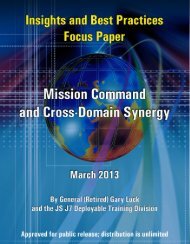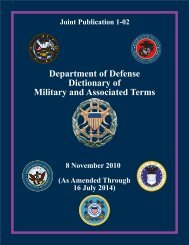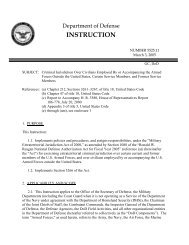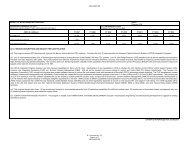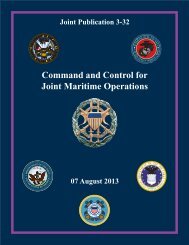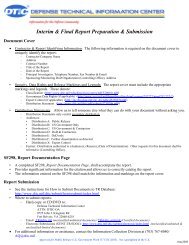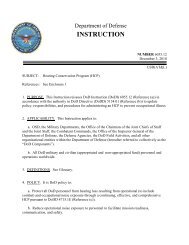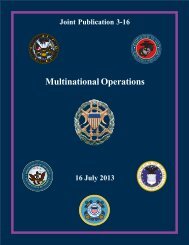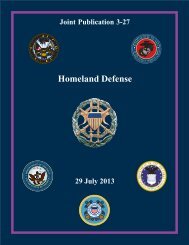JP 1, Doctrine for the Armed Forces of the United States - Defense ...
JP 1, Doctrine for the Armed Forces of the United States - Defense ...
JP 1, Doctrine for the Armed Forces of the United States - Defense ...
Create successful ePaper yourself
Turn your PDF publications into a flip-book with our unique Google optimized e-Paper software.
Chapter VI<br />
policy must first be implemented and/or new capabilities fielded be<strong>for</strong>e <strong>the</strong>y can be written<br />
into doctrine.<br />
(5) When <strong>the</strong> <strong>Armed</strong> <strong>Forces</strong> <strong>of</strong> <strong>the</strong> <strong>United</strong> <strong>States</strong> participate in multinational<br />
operations, US commanders should follow multinational doctrine and procedures that were<br />
ratified by <strong>the</strong> US. For multinational doctrine and procedures not ratified by <strong>the</strong> US,<br />
commanders should evaluate and follow <strong>the</strong> multinational command’s doctrine and<br />
procedures where applicable and consistent with US law, policy, and doctrine.<br />
(6) Joint doctrine is developed under <strong>the</strong> aegis <strong>of</strong> <strong>the</strong> CJCS in coordination and<br />
consultation with <strong>the</strong> Services, CCMDs, and CSAs. The Joint Staff leads <strong>the</strong> joint doctrine<br />
development community and is responsible <strong>for</strong> all aspects <strong>of</strong> <strong>the</strong> joint doctrine process, to<br />
include promulgation.<br />
For fur<strong>the</strong>r guidance on <strong>the</strong> development <strong>of</strong> joint doctrine, refer to CJCSI 5120.02C, Joint<br />
<strong>Doctrine</strong> Development System.<br />
b. Purpose <strong>of</strong> Joint <strong>Doctrine</strong><br />
Joint doctrine is written <strong>for</strong> those who:<br />
(1) Provide strategic direction to joint <strong>for</strong>ces (<strong>the</strong> CJCS and CCDRs).<br />
(2) Employ joint <strong>for</strong>ces (CCDRs, subordinate unified commanders, or JTF<br />
commanders).<br />
(3) Support or are supported by joint <strong>for</strong>ces (CCMDs, subunified commands, JTFs,<br />
component commands, <strong>the</strong> Services, and CSAs).<br />
(4) Prepare <strong>for</strong>ces <strong>for</strong> employment by CCDRs, subordinate unified commanders,<br />
and JTF commanders.<br />
(5) Train and educate those who will conduct joint operations.<br />
5. Joint Education<br />
a. Education is a key aspect <strong>of</strong> <strong>the</strong> joint <strong>for</strong>ce development process.<br />
(1) Pr<strong>of</strong>essional military education (PME) conveys <strong>the</strong> broad body <strong>of</strong> knowledge<br />
and develops <strong>the</strong> cognitive skills essential to <strong>the</strong> military pr<strong>of</strong>essional’s expertise in <strong>the</strong> art<br />
and science <strong>of</strong> war. Additionally, affective or attitudinal learning is paired with education to<br />
better inculcate <strong>the</strong> values <strong>of</strong> joint service as discussed in Chapter I, “Theory and<br />
Foundations.”<br />
(2) Service delivery <strong>of</strong> PME, taught in a joint context, instills basic Service core<br />
competency within topics associated with joint matters. Joint education is <strong>the</strong> aspect <strong>of</strong> PME<br />
that focuses on imparting joint knowledge and attitudes.<br />
VI-4 <strong>JP</strong> 1



